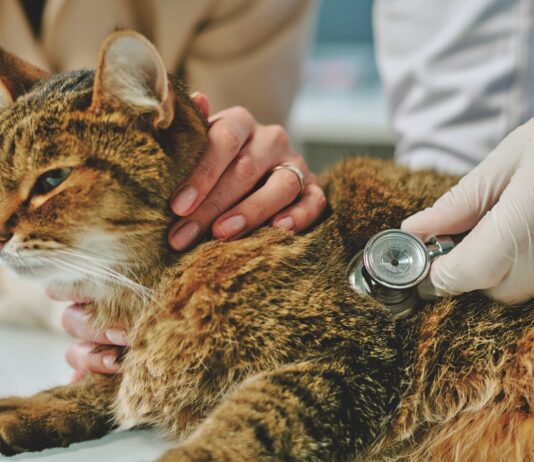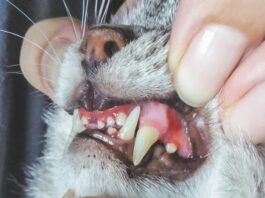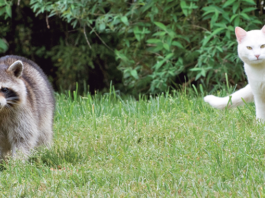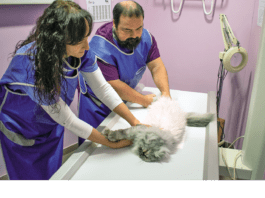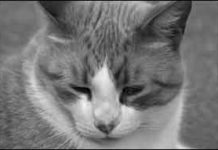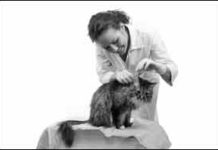Study Seeks to Identify Signs of Heart Disease
Human medicine has made strides in identifying clinical risk factors in heart disease. Now veterinary research hopes to do the same for hypertrophic cardiomyopathy in cats. It’s the most common feline heart disease and cause of cardiovascular death.
Cats With Diabetes Mellitus Have Fair to Good Prognosis
The results of studies on the life expectancy of cats with diabetes mellitus have varied widely. Now research among several European veterinary colleges, including the University of Zurich, has found cats with the disease have fair to good prospects for survival. The retrospective study of 114 cases, reported in the Journal of the American Veterinary Association, showed the median survival time of cats newly diagnosed with the disease was one year and 46 days, while 70 percent lived longer than three months, 64 percent lived longer than six months and 46 percent lived two years.
Short Takes: September 2013
The sad truth about cats’ access to veterinary care in the U.S.: They don’t have much. Surveys show that nearly twice as many dogs visit the veterinarian as cats, even though the cats outnumber dogs — 86 million versus 78 million. Thirty-nine percent of owners say they would take their cat to the veterinarian only in the event of illness; and 60 percent report that their cat hates going to the veterinary clinic. The visits may stress both owners and cats, says the American Association of Feline Practitioners. To offer a more calming, encouraging environment, it has launched an initiative to improve cats’ treatment, handling and overall health.
A Single Gene Keeps Mice Away From Cats
A specific gene affecting a mouse’s sense of smell helps it avoid predatory cats, according to research at Northwestern University. Neurobiologist Thomas Bozza, Ph.D., and his team found that removing an olfactory receptor responsible for detecting certain odors can impact a mouse’s survival. The gene, TAAR4, controls production of a receptor that detects a substance concentrated in carnivores’ urine. Usually, mice avoid the scent marks of predators, but those lacking the TAAR4 gene do not — and can end up as prey.
The Year-Round Threat of Ticks
Ticks pose a year-round threat to cats in every state — even if yours spends virtually all his time indoors. These minute arachnids have survived for millennia and often go undetected as they feed on their host’s blood, often causing serious illness and even death. “The major problem with ticks is that they are vectors for various infectious agents,” says dermatologist William H. Miller, VMD, at the Cornell University College of Veterinary Medicine.
Targeted Radiation Studied as Therapy for Oral Cancer
Treatment of oral squamous cell carcinomas (OSCC) has traditionally relied upon surgery, chemotherapy and/or radiation — with disappointing results. Cats with the rapidly spreading cancer, which accounts for 10 percent of all feline tumors, suffer pain when eating, drinking, grooming and breathing. Many are in such distress that they are euthanized.
Protecting Against a Deadly Virus
Young kittens may seem fearless when they demonstrate their acrobatic talents during play, but they’re no match for the potentially deadly disease feline panleukopenia. Sometimes referred to as feline distemper, the disease is caused by the feline panleukopenia virus (FPV). The highly contagious, hard-to-kill virus can spread from infected cats or kittens to other kittens or adult cats who haven’t been vaccinated against it. In addition, recent studies confirm that there has been crossover of the infectivity between cats and newer types of parvovirus usually found in dogs. Parvo Crossover. While some newer canine parvovirus strains can transmit the viral disease to unvaccinated cats, this does not appear to cause disease in most cases, and also does not appear to occur at a rate to cause alarm because the current vaccines used in cats provide protection.
Indoor Cats Can Get Heartworm Disease
The American Heartworm Society and American Association of Feline Practitioners have partnered to educate pet owners and veterinary professionals about the need to protect cats from heartworm disease. One misconception that they would like to correct is that indoor cats aren’t at risk for heartworm disease. In fact, one retrospective study found that 25 percent of the cats diagnosed with the disease were indoor cats. The reason: mosquitoes, which transmit the disease, can get indoors.
Easing the Discomfort of GI Sufferers
While the cure for inflammatory bowel disease remains elusive, new strides on the nutritional and pharmaceutical fronts are helping affected cats lead healthier lives. The use of novel or hydrolyzed diets coupled with the administration of the synthetic steroid prednisolone seems to offer an effective one-two therapeutic punch for most cats diagnosed with IBD, says Joseph Wakshlag, DVM, Ph.D., Associate Professor of Clinical Nutrition at the Cornell University College of Veterinary Medicine.
‘An Itchy Cat Feels Miserable’
Fortunately for cats, parasitic mites are more likely to feast on dogs, but felines aren’t home free. Affected cats can appear moth-eaten, missing patches of fur on the head, neck and ears, but mange is more than unsightly. “An itchy cat feels miserable,” says dermatologist William H. Miller, VMD, Medical Director of Cornell University Hospital for Animals. “Itchy cats often get grumpy and hide frequently, lose their appetites, and sleep a lot when they aren’t itching.” What’s more, mites can cause skin conditions ranging from dandruff to infected sores.
An Itchy Cat Feels Miserable
Fortunately for cats, parasitic mites are more likely to feast on dogs, but felines aren’t home free. Affected cats can appear moth-eaten, missing patches of fur on the head, neck and ears, but mange is more than unsightly. “An itchy cat feels miserable,” says dermatologist William H. Miller, VMD, Medical Director of Cornell University Hospital for Animals. “Itchy cats often get grumpy and hide frequently, lose their appetites, and sleep a lot when they aren’t itching.” What’s more, mites can cause skin conditions ranging from dandruff to infected sores.
The Most Common Neurological Disease
Advances in medications have given veterinarians and cat owners more choices for controlling seizures with fewer side effects. The most commonly used medications are phenobarbital and the newer drugs zonisamide and levetiracetam. “These anti-epileptic medications modify neural transmission in the brain to reduce the number of seizures an animal experiences,” says neurologist Sofia Cerda-Gonzalez, DVM, Assistant Professor of Neurology and Neurosurgery at the Cornell University College of Veterinary Medicine.

